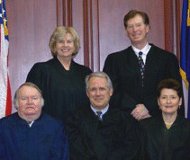Article from: www.thenewspaper.com/news/40/4042.asp
3/6/2013
Vermont Supreme Court Upholds Visual Estimate Of Speeding
Visual estimate of speed justifies traffic stop in Vermont Supreme Court ruling.
 A police officer in Vermont can now pull over any vehicle if he has a feeling it may be speeding. The state's highest court concluded last Friday that a visual estimate of speed sufficed to justify a traffic stop.
A police officer in Vermont can now pull over any vehicle if he has a feeling it may be speeding. The state's highest court concluded last Friday that a visual estimate of speed sufficed to justify a traffic stop.
The court considered the combined cases of Todd Dunham and Heidi Tatham. On December 10, 2011, a Vermont State Trooper was sitting in a parking lot in Fairlee when Dunham drove past in his pickup truck on Route 5. Because of the distance, the trooper was unable to use radar, but he turned his head around, looking across his shoulder to guess Dunham, who by then was more than 100 feet away, was doing 45 MPH in a 30 MPH zone. Dunham was stopped and found to be driving under the influence (DUI).
On September 15, 2011, another trooper in Bradford saw Tatham driving on Main Street. The trooper was positioned perpendicular to Tatham, making a radar reading impossible so he guessed she was traveling at 45 MPH in a 25 MPH zone. Tatham was also stopped and eventually arrested for DUI. Both drivers moved to suppress the evidence against them because, they argued, the troopers had no probable cause to stop them on a mere hunch that they might be speeding. The Vermont court explained the conditions for a legitimate stop.
"A mere conclusory statement as to a violation will not suffice," Justice Marilyn Skoglund wrote. "An officer must articulate facts, which, in light of his experience and personal knowledge, together with reasonable inferences drawn from those facts, would warrant a temporary intrusion on the freedom of the person detained."
The ruling found the visual guess of a speed met the standard of an articulable fact. In defense of the position, the Vermont justices cited the authority of a federal case that had been based on a 2010 Ohio Supreme Court decision upholding visual estimates. In a more recent federal ruling, however, the Fourth Circuit US Court of Appeals declared such estimates "absurd." In addition, the Ohio legislature wasted no time in enacting a law that directly overturned the Ohio Supreme Court's decision (view law). The Vermont court did not agree.
"A police officer does not need to know the exact speed at which an automobile is traveling in order to make a stop for a traffic violation," Justice Skoglund ruled. "More often, evidence that officers receive proper roadside and academy training, spend considerable time on road patrol, gain experience estimating speed and comparing estimates against radar, and historically exhibit a margin of error of only a few miles per hour, serves to qualify officers to estimate speed"
The officers involved in the case testified their training allowed them to reliably conduct a visual estimate within 5 MPH of a vehicle's actual speed. The court found such rough accuracy more than sufficient.
"What is more compelling in these cases, is the fact that in both instances the observed speed was significantly higher than the posted speed limit, such that the difference would be discernible to a casual observer, particularly a trained law enforcement officer."
The court found the use of radar and laser guns merely makes it easier to obtain a conviction without the need of establishing a police officer's training in visual estimates.
"It is not disputed that both officers' conclusions would have been further bolstered by referencing time and distance, pacing methods, or through mechanical verification," Justice Skoglund concluded. "Nonetheless, based on the significant speed differentials, as well as the officers' experience and training, we find that the trial courts' conclusions that both officers had reasonable suspicion to effect the traffic stop is supported by the evidence."
Source: Vermont v. Dunham (Supreme Court of Vermont, 3/1/2013)
Permanent Link for this item
Return to Front Page
 A police officer in Vermont can now pull over any vehicle if he has a feeling it may be speeding. The state's highest court concluded last Friday that a visual estimate of speed sufficed to justify a traffic stop.
A police officer in Vermont can now pull over any vehicle if he has a feeling it may be speeding. The state's highest court concluded last Friday that a visual estimate of speed sufficed to justify a traffic stop.